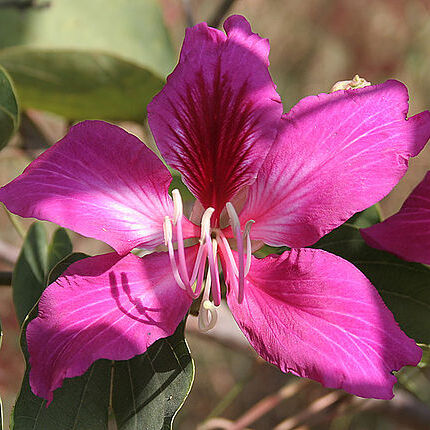Shrubs or small trees, or more generally vine-like and climbing, supported by other vegetation, unarmed or less frequently armed; trunk or stem often flattened, usually with hard wood and longitudinally striate bark. Branchlets with con-spicuous alternate nodes, often appearing somewhat zigzag-jointed, sometimes tendriled. Leaves diagnostic, inconspicuously caducous-stipulate, petiolate, simple but usually profoundly 2-lobed or sometimes 2-foliolate, rounded to cordate basally, conspicuously callused at insertion of leaf and petiole, bilobed apically, lobes more or less lanceolate. Inflorescence terminal or axillary near end of the branchlets, few-to many-flowered. Flowers usually whitish, conspicuous; calyx 5-parted, with a short or long conspicuous tube, the limb often spathaceous; petals 5, free, small or large, mostly unequal, clawed; fertile stamens 10 or 5 or in introduced species 1 or 3; anthers versatile or subversatile, usually sagittate basally; ovary usually stipitate or substipitate; legume compressed, elastically dehiscent.
Trees, shrubs, or lianas, hermaphroditic, monoecious, andromonoecious, or androdioecious. Leaves simple, bilobed or entire, rarely 2-foliolate with a shared upper pulvinus; primary veins 3-15, midvein ending with a free, small point; stipules caducous. Inflorescences solitary flowers, or many flowers in racemes, panicles, or corymbs; bracts and bracteoles usually small and caducous. Hypanthium cupular, campanulate, or tubular. Calyx closed or open with 5 short or linear teeth at apex in bud, at anthesis spathaceous, or regularly or irregularly split into 2-5 lobes. Petals 5, subequal to strongly differentiated, subsessile or prominently clawed, white, yellowish orange, pink, or purplish red. Stamens 2, 3, 5, or 10; anthers dorsifixed, longitudinally dehiscent. Staminodes present or not. Ovary 1-to many ovuled, sessile or with stalk; stigma small or prominent, variously shaped. Fruit flat, elliptic, oblong, obovoid, or linear, woody or thinly valved, dehiscent or indehiscent. Seeds few to many; endosperm present or not.
Shrubs, small trees or climbers, unarmed, with or without tendrils, evergreen or briefly deciduous. Leaves: stipules narrow, acute, caducous; petiole swollen at apex; rachis ending in a short apiculum; lamina bilobed or appearing 1-foliolate, or of 2 free leaflets, palmately veined. Flowers solitary in upper axils or in few-or many-flowered racemes, sometimes paniculately branched, sometimes unisexual; buds ovoid or fusiform with tubular receptacle; bracts small. Sepals 5, free or united and then spathe-like and split on 1 side, or campanulate and dentate. Petals 5, free, similar, obovate, long-clawed. Stamens 1-10, all or most fertile, sometimes with staminodes, free or connate, exceeding petals; anthers dorsifixed, versatile. Ovary long-stipitate; style slender; stigma small, commonly peltate; ovules 1-several. Pods oblong to linear, stipitate, few-to many-seeded, ±woody or thin, dehiscent or indehiscent. Seeds flattened.
Shrubs or small trees or rarely (and not in Flora area) climbers. Tendrils absent. Leaves simple, conspicuously bilobed, rarely divided as far as the base. Flowers usually large and showy, hermaphrodite, arranged in short usually few-flowered racemes or solitary. Calyx spathaceous (the sepals ± cohering after the calyx has opened). Petals 5. Fertile stamens 1–10, sometimes accompanied by staminodes; filaments ± hairy below in native species, often glabrous in the introduced ones. Style elongate; stigma capitate or small, sometimes ± unilateral; funicle of ovule short, at top often with 2 short outgrowths appressed to the seed, one of which may be ± suppressed. Pods oblong to linear, few-to many-seeded, ± woody, dehiscent or rarely (not in East Africa) indehiscent.
Seeds ± compressed; hilum circular or crescent-shaped, with a U-shaped to hairpin-shaped scar of 2 aril lobes developed from the funicle.
Pods linear-oblong to strap-shaped or broadened upwards, ± woody, dehiscent or elsewhere occasionally indehiscent, few-to many-seeded.
Calyx spathaceous (the sepals ± cohering after the calyx has opened) above a variably developed hypanthium.
Trees or shrubs, seldom scandent or climbing, without tendrils, but branch tips sometimes coiling.
Stamens 1–10, sometimes accompanied by staminodes, free; anthers opening by longitudinal slits.
Leaves bilobed or occasionally divided to the base, palmately nerved; stipules deciduous.
Ovary usually stipitate; style elongate; stigma capitate or small, sometimes unilateral.
Flowers in racemes or solitary, usually large and showy, bisexual, zygomorphic.
Petals 5(6), free.

